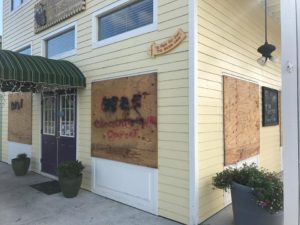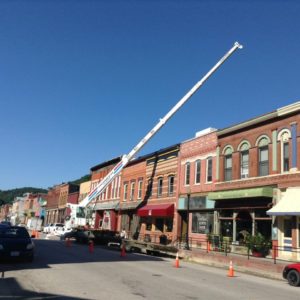When Disaster Strikes
By Keith Loria, Special to Gift Shop

It seems every time one turns on the news today, there’s a report about another natural disaster occurring in 2017. Hurricanes Harvey and Irma devastated Florida, more than a dozen wildfires scorched Northern California and the U.S. is seeing a record number of tornadoes this year.
Unfortunately, with all this disaster, many gift shops have been faced with ruined inventory, damage to infrastructure and a host of challenges never expected.
There are some things that stores can do ahead of time to protect themselves. For example, having a disaster preparation plan and/or checklist in place before something hits is advisable so one can respond quickly and effectively.
Then once something happens, but your plan in place.
“Utilize your social media accounts during and after a disaster — the photos and posts might shore up some volunteers in your community to help clean up,” said David Bakke, a financial blogger at Money Crashers. “Your current customers might be able to get you back up and running quickly as well.”
Other things to do include contacting your vendors and suppliers and alerting them of what happened — you might get a few extra days to catch up on bills and payments.
“You should also review your insurance plan now so you know you have the right coverage if one hits,” Bakke said. “You’re looking for replacement cost for your items which are damaged or destroyed. Get photos of all damage before clean up begins. Take care of any of the easier repairs yourself to keep costs down.”

Feeling the effects
On April 19, the town of McGregor, Iowa was struck by a tornado, and the Paper Moon gift shop (and its 1864-constructed building) was hit hard. Louise White, co-owner of the store, said debris damaged the retailer’s windows and rooftop solar panels, plus there was lots of flooding inside. Six months later, the town was still recovering and Paper Moon still needed repairs.
“No one knew this was coming, so we didn’t have time to prepare,” White said. “It’s a small town, so it’s been hard to find tradesman to do repairs. It took almost three weeks to fix the glass, so we used tarps on the front, and the roof was just fixed in October.”
The town received FEMA help, which was used to clean up tree damage and help the buildings that were destroyed from the tornado.
One thing White has since done to prepare if something ever happens again, is she filled the store’s basement with supplies and made it more comfortable in case she’s ever forced to wait down there during another storm.
“My biggest tip is to have a local insurance agent,” she said. “They’ve been with us since the beginning, and my adjuster was very calming and worked with me.”
Shannon Talley, manager of the family-run Market on the Square gift store in St. Marys, Georgia, said the store flooded after Hurricane Matthew earlier in the year, and then flooded again after Hurricane Irma. In both cases, they lost power for about a week.
“We were a bit better prepared this time. We had a huge sale and sold out of our ice cream and fudge, and all the edible stuff we could,” she said. “And then we rented a U-Haul and loaded our whole entire store, so the flood made a mess but didn’t affect our products.”
Virginia Thomas, owner of Ann Page, a Houston-based store offering paper, gifts and more, saw its wholesale office down for three full weeks as a result of Hurricane Harvey.
The office was on the second floor, and Thomas had no plan in place because she didn’t think the storm would be as bad as it was.
“Our office is very close to the Barkers reservoir, which is one of the dams that was compromised due to 54 inches of rain in less than 72 hours,” she said. “Before we left, we turned off our computers, unplugged everything and covered all shippable product in case of roof leaks.”
While the office itself sustained minimal problems, the true damage was to several employees’ homes and the roads around the store.
“Roads leading to our office were completely impassable as well as there being no electricity or water to the office,” she said. “September is a very hard time for us to be displaced because as you can imagine, we are quite busy shipping orders for the fourth quarter. For the most part, people have been very understanding while realizing that this was completely out of our control. At this time we are trying to pick up the pieces, while repairing our flooded homes, and move forward the best way we know.”

Help is out there
A spokesperson for the U.S. Small Business Administration says small businesses affected by any disaster can apply for low-interest disaster loans, as well as receive business counselling at one of its registered disaster recovery centers or online at disasterloan.sba.gov/ela.
Insurance matters
Obviously, disaster insurance is important in areas prone to hurricanes, tornados, earthquakes, etc., but sometimes there’s more that’s required.
Brad Plothow, head of communications for Womply, which helps more than 100,000 small businesses, says the company’s research has shown that many main street businesses are improperly insured.
“For example, we recently polled 2,300 small business owners in all 50 states, and we learned that only 28 percent of merchants who say a natural disaster would be ‘extremely damaging’ to their business have disaster insurance,” he said. “In the same survey, we found that 1 in 5 small businesses wouldn’t last 30 days if sales stopped entirely.”
That’s why insuring against revenue loss is vital to survival, even if a store has insurance for damage to the physical property.
“The loss of sales revenue during a renovation, rebuild, or return to normal consumer activity could be a death knell,” Plothow said. “We recommend business interruption insurance as well.”
John Espenschied, owner of Insurance Brokers Group, St Louis, Mo., says his number one recommendation to gift shop retailers is to make sure they have business continuation insurance coverage, which when added to a BOP business owners’ policy will provide money to pay the rent, utilities, invoices and most importantly, employees.
“Putting aside the fact you may or may not be able to return to your current location, you still have on-going bills and employees looking for a pay check,” he said. “This coverage is going to help based on a specific dollar amount listed on your DEC page of the policy and/or for a period of time per the policy. Talk with your insurance professional and decide how much money would be needed to restore the business to normal operations.”
If a disaster does happen, Espenschied recommended documenting the remnants of the destruction, i.e. flood waters while it’s still in the building, if possible.
“Take photos — and even better, video to document. If you are in area hit hard by a natural disaster, chances are the claims adjuster will not be there the next day,” he said. “By the time they do show up, the water will be gone and the adjuster may not have a clear picture of the amount of damage to equipment used in the business. We also recommend taking photos of the business now, before a disaster, and store it in a cloud-based hard drive.”
Remember, there’s nothing one can do to prevent a natural disaster, but a store can set itself up for success afterwards, and that can mean the difference between closing the door or getting back to work.
A graduate of the University of Miami, Keith Loria is an award-winning journalist who has been writing for major newspapers and magazines for close to 20 years, on topics as diverse as sports, business, theater, and retail. He started his career with the Associated Press and has held high editorial positions at Rinkside, BCA Insider and Soap Opera Digest. You can view some of his recent writing at keithloria.contently.com.
Photos courtesy of Paper Moon Books and Gifts and Market on the Square.























